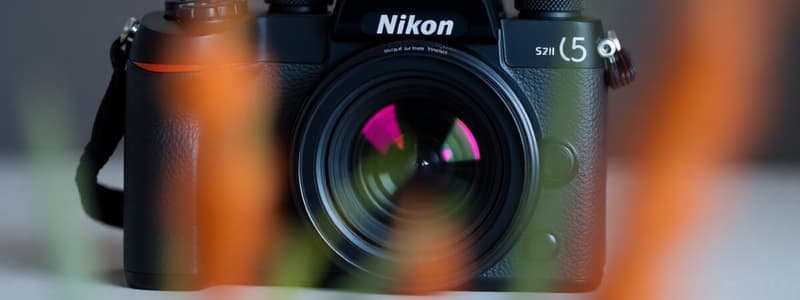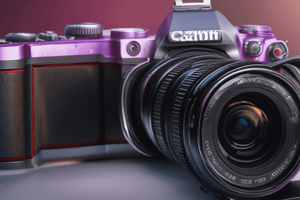Podcast
Questions and Answers
What is the approximate megapixel count of the Nikon Z5II's full-frame sensor?
What is the approximate megapixel count of the Nikon Z5II's full-frame sensor?
- 30.1 megapixels
- 45.7 megapixels
- 20.8 megapixels
- 24.5 megapixels (correct)
Which image processor is used in the Nikon Z5II?
Which image processor is used in the Nikon Z5II?
- EXPEED 7 (correct)
- EXPEED 4
- EXPEED 6
- EXPEED 5
What is the maximum ISO sensitivity for stills on the Nikon Z5II?
What is the maximum ISO sensitivity for stills on the Nikon Z5II?
- ISO 25600
- ISO 64000 (correct)
- ISO 128000
- ISO 32000
What type of memory cards are compatible with the Nikon Z5II?
What type of memory cards are compatible with the Nikon Z5II?
What is the frame coverage of the Nikon Z5II's viewfinder?
What is the frame coverage of the Nikon Z5II's viewfinder?
Which video recording format options are available on the Nikon Z5II?
Which video recording format options are available on the Nikon Z5II?
What is the purpose of the 'Picture Control' button on the Nikon Z5II?
What is the purpose of the 'Picture Control' button on the Nikon Z5II?
Which of the following is a feature of the Nikon Z5II's autofocus system?
Which of the following is a feature of the Nikon Z5II's autofocus system?
What is the maximum video recording frame rate at Full HD resolution on the Nikon Z5II, and what slow motion effect can it create?
What is the maximum video recording frame rate at Full HD resolution on the Nikon Z5II, and what slow motion effect can it create?
What type of shutter does the Nikon Z5II employ?
What type of shutter does the Nikon Z5II employ?
When using Center-weighted metering on the Nikon Z5II, what percentage of weight is given to the center of the frame?
When using Center-weighted metering on the Nikon Z5II, what percentage of weight is given to the center of the frame?
What is the approximate magnification of the Nikon Z5II's viewfinder?
What is the approximate magnification of the Nikon Z5II's viewfinder?
What is the effect of the Nikon Z5II's in-camera Vibration Reduction (VR) when using compatible lenses?
What is the effect of the Nikon Z5II's in-camera Vibration Reduction (VR) when using compatible lenses?
What are the available bracketing types on the Nikon Z5II?
What are the available bracketing types on the Nikon Z5II?
What is the highest ISO sensitivity available for video recording when N-Log is selected for tone mode on the Nikon Z5II?
What is the highest ISO sensitivity available for video recording when N-Log is selected for tone mode on the Nikon Z5II?
What type of AF-area modes are available in video mode on the Nikon Z5II?
What type of AF-area modes are available in video mode on the Nikon Z5II?
Which Picture Control options are available when HLG is selected for tone mode during still photography on the Nikon Z5II?
Which Picture Control options are available when HLG is selected for tone mode during still photography on the Nikon Z5II?
If you are shooting in NEF (RAW) + JPEG format on the Nikon Z5II, what dual card slot configurations are available?
If you are shooting in NEF (RAW) + JPEG format on the Nikon Z5II, what dual card slot configurations are available?
What is the Auto FP high-speed sync shutter speed of the Nikon Z5II?
What is the Auto FP high-speed sync shutter speed of the Nikon Z5II?
What is the approximate weight of the Nikon Z5II body only, without battery, memory card, body cap, or accessory shoe cover?
What is the approximate weight of the Nikon Z5II body only, without battery, memory card, body cap, or accessory shoe cover?
Which of the following statements is most accurate regarding battery compatibility with the Nikon Z5II?
Which of the following statements is most accurate regarding battery compatibility with the Nikon Z5II?
Which of the following best describes the function of the 'high-frequency flicker reduction' feature?
Which of the following best describes the function of the 'high-frequency flicker reduction' feature?
The Nikon Z5II supports various Creative Picture Controls like Dream, Morning, Pop, etc. Which of these options correctly describes the tunability of these controls?
The Nikon Z5II supports various Creative Picture Controls like Dream, Morning, Pop, etc. Which of these options correctly describes the tunability of these controls?
The Nikon Z5II has a feature called “Pre-Release Capture”. In which release mode(s) is this feature available?
The Nikon Z5II has a feature called “Pre-Release Capture”. In which release mode(s) is this feature available?
Which statement accurately describes the capabilities of the Nikon Z5II's electronic viewfinder (EVF)?
Which statement accurately describes the capabilities of the Nikon Z5II's electronic viewfinder (EVF)?
What is the minimum EV (Exposure Value) that the Nikon Z5II can detect in its autofocus system under the following conditions; photo mode, AF-S, single-point AF with the center focus point selected, ISO 100 equivalent, f/1.2 lens, 20°C/68°F?
What is the minimum EV (Exposure Value) that the Nikon Z5II can detect in its autofocus system under the following conditions; photo mode, AF-S, single-point AF with the center focus point selected, ISO 100 equivalent, f/1.2 lens, 20°C/68°F?
What combination of settings would provide the highest maximum frame advance rate when using continuous high-speed mode on the Nikon Z5II?
What combination of settings would provide the highest maximum frame advance rate when using continuous high-speed mode on the Nikon Z5II?
With its subject detection capabilities, the Nikon Z5II can automatically detect and focus on a variety of subjects. Consider a scenario where you're photographing a mixed group of subjects. Which of the following describes the most comprehensive subject detection behavior you can expect from the camera?
With its subject detection capabilities, the Nikon Z5II can automatically detect and focus on a variety of subjects. Consider a scenario where you're photographing a mixed group of subjects. Which of the following describes the most comprehensive subject detection behavior you can expect from the camera?
The Nikon Z5II features an option for 'dual-format (proxy-video) recording for RAW video'. What best describes the primary advantage of utilizing this feature?
The Nikon Z5II features an option for 'dual-format (proxy-video) recording for RAW video'. What best describes the primary advantage of utilizing this feature?
The Nikon Z5II includes 'RED LUTs for N-Log'. What part do RED LUTs play in N-Log video recording?
The Nikon Z5II includes 'RED LUTs for N-Log'. What part do RED LUTs play in N-Log video recording?
The Nikon Z5II supports an external microphone with adjustable sensitivity and other audio functions. What specific functions are available for audio recording?
The Nikon Z5II supports an external microphone with adjustable sensitivity and other audio functions. What specific functions are available for audio recording?
What is the approximate depth (D) dimension of the Nikon Z5II?
What is the approximate depth (D) dimension of the Nikon Z5II?
The Nikon Z5II vari-angle LCD monitor has a viewing angle of 170°. What practical benefit does this wide viewing angle provide to photographers and videographers?
The Nikon Z5II vari-angle LCD monitor has a viewing angle of 170°. What practical benefit does this wide viewing angle provide to photographers and videographers?
Which of the following best explains the purpose of Image Dust Off reference data?
Which of the following best explains the purpose of Image Dust Off reference data?
A photographer wants to maximize dynamic range while shooting video with the Nikon Z5II. Which combination of settings would best achieve this goal?
A photographer wants to maximize dynamic range while shooting video with the Nikon Z5II. Which combination of settings would best achieve this goal?
A photographer is using an older F mount NIKKOR lens with the Nikon Z5II. Which of the following statements is most accurate?
A photographer is using an older F mount NIKKOR lens with the Nikon Z5II. Which of the following statements is most accurate?
How does the Nikon Z5II's 'Highlight-weighted metering' mode determine exposure?
How does the Nikon Z5II's 'Highlight-weighted metering' mode determine exposure?
What is the resolution of the Nikon Z5II’s vari-angle TFT touch-sensitive LCD monitor?
What is the resolution of the Nikon Z5II’s vari-angle TFT touch-sensitive LCD monitor?
Flashcards
Nikon Z mount camera
Nikon Z mount camera
A digital camera that supports interchangeable lenses using the Nikon Z mount.
Effective Pixels
Effective Pixels
The number of pixels used to form an image, specified as 24.5 million for this camera.
Full-frame CMOS sensor
Full-frame CMOS sensor
A 35.9 x 23.9 mm sensor size, providing a full-frame field of view.
Image sensor cleaning
Image sensor cleaning
Signup and view all the flashcards
File format (image quality)
File format (image quality)
Signup and view all the flashcards
Picture Control system
Picture Control system
Signup and view all the flashcards
Compatible Memory Cards
Compatible Memory Cards
Signup and view all the flashcards
Dual card slots
Dual card slots
Signup and view all the flashcards
Electronic Viewfinder (EVF)
Electronic Viewfinder (EVF)
Signup and view all the flashcards
Frame coverage
Frame coverage
Signup and view all the flashcards
Viewfinder Magnification
Viewfinder Magnification
Signup and view all the flashcards
Vari-angle LCD monitor
Vari-angle LCD monitor
Signup and view all the flashcards
Shutter Type
Shutter Type
Signup and view all the flashcards
Shutter Speed Range
Shutter Speed Range
Signup and view all the flashcards
Single frame release mode
Single frame release mode
Signup and view all the flashcards
Continuous shooting mode
Continuous shooting mode
Signup and view all the flashcards
Frame advance rate (fps)
Frame advance rate (fps)
Signup and view all the flashcards
Metering system
Metering system
Signup and view all the flashcards
Metering mode
Metering mode
Signup and view all the flashcards
Metering range
Metering range
Signup and view all the flashcards
ISO sensitivity range
ISO sensitivity range
Signup and view all the flashcards
Active D-Lighting
Active D-Lighting
Signup and view all the flashcards
HDR overlay
HDR overlay
Signup and view all the flashcards
Autofocus (AF)
Autofocus (AF)
Signup and view all the flashcards
Hybrid phase-detection/contrast AF
Hybrid phase-detection/contrast AF
Signup and view all the flashcards
Detection range (AF)
Detection range (AF)
Signup and view all the flashcards
Focus points
Focus points
Signup and view all the flashcards
AF-area modes
AF-area modes
Signup and view all the flashcards
Vibration Reduction (VR)
Vibration Reduction (VR)
Signup and view all the flashcards
Flash control
Flash control
Signup and view all the flashcards
Flash modes
Flash modes
Signup and view all the flashcards
Nikon Creative Lighting System (CLS)
Nikon Creative Lighting System (CLS)
Signup and view all the flashcards
White balance
White balance
Signup and view all the flashcards
Bracketing
Bracketing
Signup and view all the flashcards
Video Frame Size and Rate
Video Frame Size and Rate
Signup and view all the flashcards
Video File Format
Video File Format
Signup and view all the flashcards
Video Compression
Video Compression
Signup and view all the flashcards
Audio Recording Format
Audio Recording Format
Signup and view all the flashcards
USB Type C
USB Type C
Signup and view all the flashcards
HDMI output
HDMI output
Signup and view all the flashcards
Study Notes
- The Nikon Z5II is a mirrorless camera with interchangeable lenses and a Nikon Z mount.
- It supports both Z mount and F mount NIKKOR lenses (with an adapter; some restrictions may apply).
Key Specs
- Effective Pixels: 24.5 million
- Image Sensor: 35.9 x 23.9 mm CMOS (full-frame/FX-format)
- ISO Sensitivity: 100 to 64000 (expandable to 50-204800 equivalent)
- Continuous Shooting: Up to 30 fps with Pre-Release Capture
- Video: 4K UHD/60p (cropped), Full HD/120p
- VR: 7.5-stop in-camera VR
- Subject Detection: 9 subject types
- Image Processor: EXPEED 7
Image Quality and Storage
- It has an Image sensor cleaning system and Image Dust Off reference data (with NX Studio).
- Image sizes range from 6048 x 4032 to 1984 x 1328 depending on the image area selected (FX, DX, 1:1, 16:9).
- Image file formats include NEF (RAW), JPEG, and HEIF, with various compression options.
- RAW files are 14-bit and can be compressed.
- It supports Custom Picture Controls, with some restrictions when HLG is selected for tone mode.
- It has dual SD card slots that support SD, SDHC, and SDXC cards (UHS-II compliant).
- Either card can be used for overflow, backup, or separate storage of RAW and JPEG/HEIF files.
Viewfinder and Monitor
- It uses a 1.27-cm/0.5-in. 3690k-dot OLED electronic viewfinder with color balance and brightness controls.
- The Viewfinder frame coverage is approximately 100% horizontal and vertical with magnification about 0.8x.
- The Monitor is an 8-cm/3.2-in. 2100k-dot vari-angle TFT touch-sensitive LCD with 170° viewing angle and 100% frame coverage.
Shutter
- It has an Electronically-controlled vertical-travel focal-plane mechanical shutter, electronic front-curtain shutter, and electronic shutter.
- Shutter speed ranges from 1/8000 to 30 s, extendable to 900 s in mode M, with Bulb and Time options.
- Flash sync speed is 1/200 s or slower, with auto FP high-speed sync supported.
- Available release modes are Single frame, continuous low/high-speed, high-speed frame capture with Pre-Release Capture, and self-timer.
- Continuous shooting can reach 1 to 7 fps in continuous low-speed mode and up to 15 fps in continuous high-speed (extended) mode (with silent mode on).
Exposure and Metering
- TTL metering uses the camera's image sensor.
- Metering modes: Matrix, Center-weighted, Spot, and Highlight-weighted.
- Metering range: -4 to +17 EV (ISO 100, f/2.0, 20°C/68°F).
- ISO sensitivity ranges from 100 to 64000, with options to go below ISO 100 or above ISO 64000.
- Active D-Lighting options: Auto, Extra high, High, Normal, Low, and Off.
- It offers multiple exposure modes: Add, average, lighten, darken, HDR overlay, photo flicker reduction, and high-frequency flicker reduction.
Autofocus
- Utilizes Hybrid phase-detection/contrast AF with AF assist.
- AF Detection range: -10 to +19 EV (photo mode, AF-S, single-point AF, ISO 100, f/1.2, 20°C/68°F).
- Focus points: 273 points (single-point AF), 299 points (auto-area AF) in photo mode with FX selected.
- AF-area modes: Pinpoint, single-point, dynamic-area (S, M, L), wide-area (S, L, C1, C2), auto-area AF, 3D-tracking (photo mode), and subject-tracking AF (video mode).
Vibration Reduction
- Camera on-board VR: 5-axis image sensor shift.
- Lens on-board VR: Lens shift (with VR lenses).
Flash
- Flash control: i-TTL flash control with matrix, center-weighted, and highlight-weighted metering.
- Flash modes: Front-curtain sync, slow sync, rear-curtain sync, red-eye reduction, and off.
- Nikon Creative Lighting System (CLS) support: i-TTL flash control, optical Advanced Wireless Lighting, modeling illumination, FV lock, Color Information Communication, and auto FP high-speed sync.
White Balance
- White balance: Auto (3 types), natural light auto, direct sunlight, cloudy, shade, incandescent, fluorescent (3 types), flash, color temperature (2500 to 10,000 K), and preset manual (up to 6 values).
- Bracketing options: Exposure, flash, white balance, and ADL.
Video Recording
- Video Metering: TTL metering using camera image sensor (Matrix, center-weighted, or highlight-weighted).
- 4K UHD recording at 60p/50p/30p/25p/24p and 1080p at 120p/100p/60p/50p/30p/25p/24p.
- Slow-motion recording at 30p x4, 25p x4, and 24p x5.
- RAW video recording available.
- File formats: NEV, MOV, MP4 with N-RAW (12 bit), H.265/HEVC (8/10 bit), and H.264/AVC (8 bit) compression.
- It supports Linear PCM or AAC audio recording, with built-in stereo mic or external mic options.
- ISO sensitivity: 100-51200 in manual mode (expandable), with auto ISO control in P, S, and A modes.
- Video Features include time-lapse, electronic VR, time codes, N-Log, HLG, wave-form display, and more.
Interface
- USB: Type C SuperSpeed USB connector.
- HDMI: Type-D HDMI connector.
- Audio input/output: 3.5 mm stereo mini-pin jacks.
- Wi-Fi and Bluetooth are available.
Power
- Battery: EN-EL15c Rechargeable Li-ion Battery (compatible with EN-EL15b/EN-EL15a, but with reduced performance).
- Optional MB-N14 and MB-N11 Power Battery Packs are available.
- AC adapter: EH-8P (requires USB cable) or EH-5d/EH-5c/EH-5b (requires EP-5B Power Connector).
Physical Specs
- Tripod socket: 0.635 cm; 1/4 in., ISO 1222.
- Dimensions: Approx. 134 x 100.5 x 72 mm/5.3 x 4 x 2.9 in.
- Weight: Approx. 700 g/1 lb. 8.7 oz. (with battery and memory card).
- Operating environment: 0°C to 40°C (32°F to 104°F), humidity: 85% or less (no condensation).
Studying That Suits You
Use AI to generate personalized quizzes and flashcards to suit your learning preferences.




